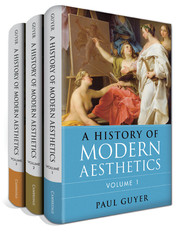Book contents
- Volume 1 The Eighteenth Century
- Volume 2 The Nineteenth Century
- Volume 3 The Twentieth Century
- Frontmatter
- Contents
- Acknowledgments
- Introduction
- Part One German Aesthetics in the Twentieth Century
- Part Two Aesthetics in Britain until World War II
- Part Three American Aesthetics in the First Half of the Twentieth Century
- Part Four Wittgenstein and After
- 11 Wittgenstein
- 12 The First Wave
- 13 The Second Wave
- Epilogue Truth, Feeling, and Play in Recent Aesthetics
- Bibliography
- References
11 - Wittgenstein
from Part Four - Wittgenstein and After
Published online by Cambridge University Press: 05 June 2015
- Volume 1 The Eighteenth Century
- Volume 2 The Nineteenth Century
- Volume 3 The Twentieth Century
- Frontmatter
- Contents
- Acknowledgments
- Introduction
- Part One German Aesthetics in the Twentieth Century
- Part Two Aesthetics in Britain until World War II
- Part Three American Aesthetics in the First Half of the Twentieth Century
- Part Four Wittgenstein and After
- 11 Wittgenstein
- 12 The First Wave
- 13 The Second Wave
- Epilogue Truth, Feeling, and Play in Recent Aesthetics
- Bibliography
- References
Summary
Wittgenstein and the Tractatus
As were many other areas of Anglo-American philosophy, the field of aesthetics was transformed by the influence of Ludwig Wittgenstein (1889–1951), although in this case the magnitude of Wittgenstein’s influence was far out of proportion to the few words he himself devoted to the field in both the two books that were published at his own instigation and the vast body of writings published after his death. Wittgenstein’s first book, the 1919 Tractatus Logico-Philosophicus (as it has always been known in English, although it does not bear that pretentious Latin title in German, in which it is called simply a “Logical-Philosophical Treatise”), strongly influenced the logical positivism of the 1920s Vienna Circle, through which it in turn led several prominent British and American philosophers in the 1930s to argue that aesthetic judgments, like ethical judgments, are not verifiable judgments at all, but purely expressions of personal emotion or preference. This position, as we have already seen, did not constrain the aesthetic theorizing that continued in Britain through the 1930s and in the United States through the 1940s and even beyond in the case of such aestheticians as Langer, Beardsley, and Goodman. Wittgenstein’s second book, however, the 1953 Philosophical Investigations published after his death but largely in the form in which he intended to publish it, radically transformed the practice of aesthetics, indeed leading some of those most influenced by Wittgenstein to bemoan “The Dreariness of Aesthetics” and others to ask “Does Traditional Aesthetics Rest on a Mistake?” The immediate effect of the Investigations was to undermine the focus of aesthetics in the first half of the century on the phenomenon of aesthetic experience, the common denominator in cognitivist, play, and expressionist theories and their syntheses, and to redirect debate to the single question of whether there can be a definition of art that dominated so much aesthetic theory from the 1960s to the 1980s. However, we will see that the most innovative thinkers influenced by Wittgenstein, such as Arthur Danto, Stanley Cavell, and Richard Wollheim, managed to incorporate Wittgensteinian influences into the mainstream of traditional aesthetic thought without simply damming up that stream.
- Type
- Chapter
- Information
- A History of Modern Aesthetics , pp. 432 - 448Publisher: Cambridge University PressPrint publication year: 2014



